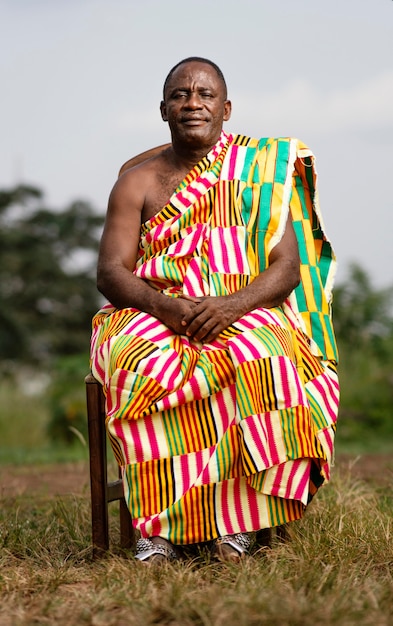
Kente cloth is also worn by the Ewe people, who were under the rule of the Asante kingdom in the late 18th century. It is believed that the Ewe, who had a previous tradition of horizontal loom weaving, adopted the style of kente cloth production from the Asante—with some important differences. Since the Ewe were not centralized, kente was not limited to use by royalty, though the cloth was still associated with prestige and special occasions. A greater variety in the patterns and functions exist in Ewe kente, and the symbolism of the patterns often has more to do with daily life than with social standing or wealth.
Ashanti men traditionally wear Kente cloth in a style that emphasizes their status and cultural pride. The method of draping the cloth has its roots in the attire of Ashanti royalty and nobility, and it continues to be worn during important cultural, social, and ceremonial events. Here's how Ashanti men wear Kente.
How Kente is worn by men
1. Draping the Kente Cloth
The Kente cloth is typically worn as a single, large piece of fabric (often about 6-9 yards long) that is wrapped around the body in a specific manner. This draping style is similar to the ancient toga worn by Roman men, symbolizing power and dignity.
Step-by-step process:
The cloth is first draped over the left shoulder, with the remaining length of the cloth wrapped around the body.
The loose end of the fabric is brought under the right arm and draped over the left shoulder again.
The right shoulder remains exposed, while the left side of the body is covered.
The cloth should hang in long, graceful folds down the body, reaching about ankle-length.
This style of wearing the Kente is especially common for chiefs, elders, and men of high status during public events like festivals, weddings, and funerals.
2. Worn During Ceremonial Occasions
Ashanti men wear Kente to signal the importance of the occasion. Whether it's a wedding, a chieftaincy ceremony, or a traditional festival, the manner in which the Kente is worn signifies respect for the event. For these occasions, the patterns and colors chosen reflect the themes of the event, such as prosperity, unity, or power.
3. Accessories and Accompanying Attire
Jewelry: Men often complement their Kente cloth with gold jewelry, which symbolizes wealth, status, and the connection to Ashanti royalty. Gold bracelets, rings, and necklaces are commonly worn.
Footwear: Traditional sandals, often made from leather, are worn with the Kente cloth.
Headgear: Some Ashanti men, especially chiefs or dignitaries, wear traditional crowns or caps, though not all men wear headgear with Kente.
Staffs or Scepters: Chiefs may carry a ceremonial staff or scepter to signify leadership and authority.
4. Significance of the Draping Style
The way Ashanti men drape the Kente cloth is not only practical but also symbolic:
Power and Dignity: The exposed right shoulder conveys strength, while the elegant folds of the cloth symbolize grace and control.
Cultural Pride: Wearing Kente in this manner is a display of cultural identity and pride, connecting the wearer to their ancestors and the Ashanti Kingdom's royal traditions.
5. Kente in Modern Contexts
While the traditional style of draping Kente remains popular for ceremonial events, modern adaptations have also emerged. Some Ashanti men may wear tailored Kente shirts, suits, or jackets for less formal occasions. However, during significant cultural ceremonies, the traditional draping style remains the most respected and widely used.
Conclusion
For Ashanti men, wearing Kente is a deeply symbolic act that ties them to their cultural roots, history, and status. The draping of Kente cloth in this elegant and stately manner is not just about fashion; it is a cultural expression of power, respect, and pride. Whether at royal events, religious ceremonies, or community festivals, the way Ashanti men wear Kente reflects the dignity and legacy of their heritage.




